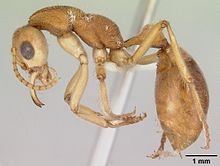- Nothomyrmecia
-
Nothomyrmecia 
Conservation status Scientific classification Kingdom: Animalia Phylum: Arthropoda Class: Insecta Order: Hymenoptera Family: Formicidae Subfamily: Myrmeciinae Tribe: Prionomyrmecini Genus: Nothomyrmecia Species: N. macrops Binomial name Nothomyrmecia macrops
Clark, 1951Nothomyrmecia macrops, sometimes called the dinosaur ant, is the only extant species of its genus. The primitive nature of the ant in behaviour and biology has resulted in the species often being considered a living fossil.
Contents
Habitat
It is found in the cool regions of the mallee of southern South Australia and Western Australia in old-growth areas populated with various Eucalyptus species.[2] These ants were of special interest to entomologists since it was believed they might offer a chance to observe and study "primitive" ant social organisation. However, N. macrops is known to possess some behavioural habits of more advanced ant species, and phylogenies of the ants indicate that other ant lineages such as Ponerinae are more properly considered "primitive" within the family.[3]
Discovery
Nothomyrmecia was originally discovered in 1931 near Balladonia in Western Australia. At the time it was thought to be living proof that ants had evolved from wasps. However the amateur naturalists who discovered the species had failed to record collection sites, so no other specimens could be found in the area. In 1977 a solitary worker ant from the species was found by Dr. Bob Taylor and his party of entomologists from Canberra at Poochera, 1300 km (800 mi) from the site of the 1931 discovery. A further colony was found at Penong, 180 km (110 mi) to the west of Poochera, but the fate of the colony discovered in 1931 is not known.[4]
Relationships
In 1998, the paleontologist C. Baroni Urbani described a new fossil species placed in the extinct genus Prionomyrmex, which was originally described in 1868. After examining specimens of N. macrops, Baroni Urbani stated his opinion that his new species and N. macrops belonged to the same genus, in which case the name Prionomyrmex would replace the name Nothomyrmecia (i.e., that Nothomyrmecia was a junior synonym of Prionomyrmex).[5] However, this synonymy has not been widely accepted by the entomological community (e.g., Ward, 2007[3]).
References
- ^ Social Insects Specialist Group (1996). "Nothomyrmecia macrops". IUCN Red List of Threatened Species. Version 2.3. International Union for Conservation of Nature. http://www.iucnredlist.org/apps/redlist/details/14849. Retrieved September 22, 2011.
- ^ Threatened Species Scientific Committee. "Dinosaur Ant, Fossil Ant (Nothomyrmecia macrops)". Department of Sustainability, Environment, Water, Population and Communities. http://www.environment.gov.au/biodiversity/threatened/species/nothomyrmecia-macrops.html. Retrieved 15 August 2010.
- ^ a b Philip S. Ward (2007). "Phylogeny, classification, and species-level taxonomy of ants (Hymenoptera: Formicidae)". Zootaxa 1668: 549–563.
- ^ Poochera travel guide from Nullarbor Net, accessed 22 April 2007
- ^ "Rediscovery of the Baltic amber ant genus Prionomyrmex (Hymenoptera, Formicidae) and its taxonomic consequences". Eclogae Geologicae Helvetiae 93: 471–480. 2000.
Categories:- IUCN Red List critically endangered species
- Living fossils
- Monotypic arthropod genera
- Myrmeciinae
Wikimedia Foundation. 2010.

